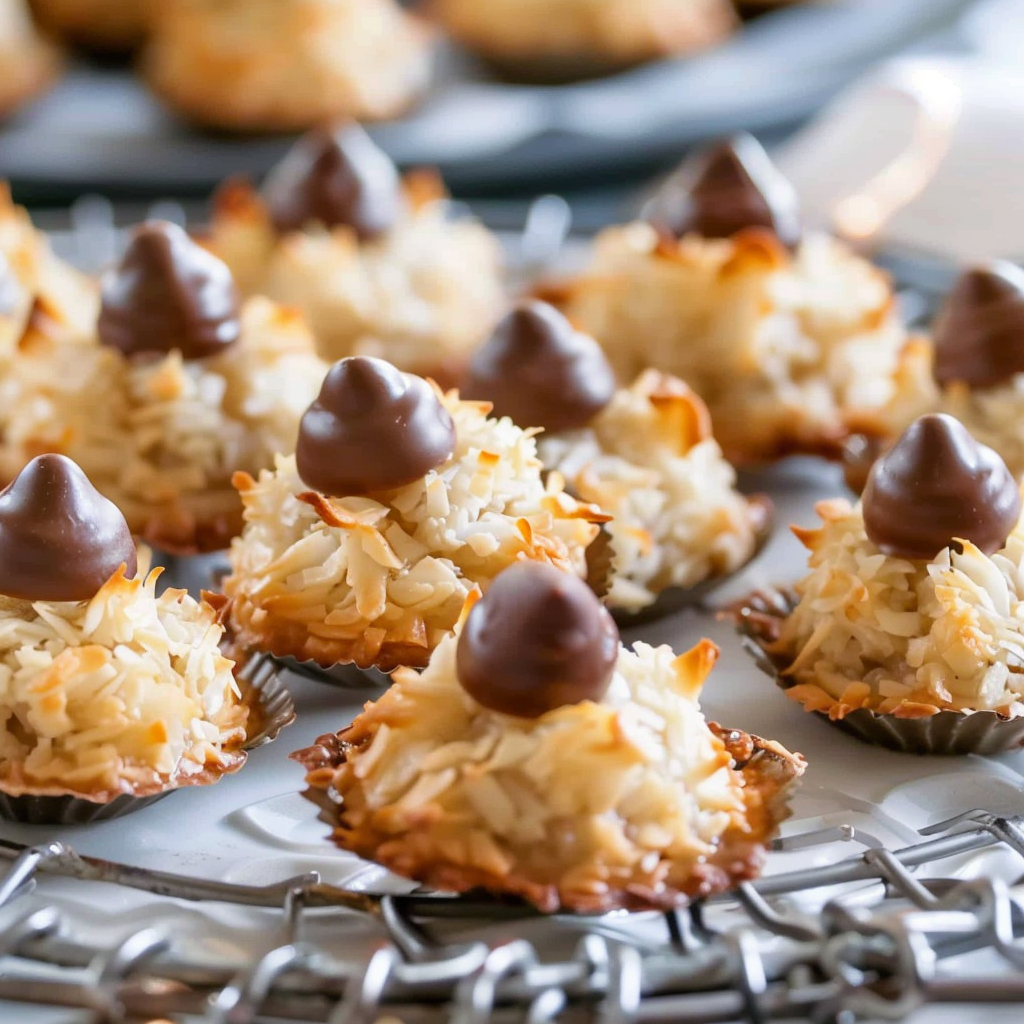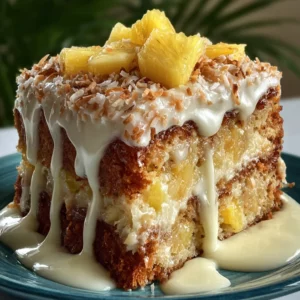Classic Coconut Macaroons Recipe You Must Try
Coconut macaroons are a simple yet indulgent treat that combines the sweetness of shredded coconut with the richness of egg whites. Whether you’re hosting a party, looking for a delightful snack, or preparing a gift, these chewy and crispy coconut macaroons are sure to impress. The crispy exterior and soft, chewy interior make them a perfect balance of textures. In this article, we will guide you through the steps for making perfect macaroons every time, ensuring they come out delicious and consistent.
Why You Should Make Coconut Macaroons at Home
Making coconut macaroons at home offers numerous benefits. Not only do you get to enjoy a fresh batch of these treats, but you also have full control over the quality of ingredients and can customize the recipe to your taste. When you make macaroons at home, you avoid the preservatives and artificial ingredients that are often found in store-bought versions. Plus, homemade macaroons are a great way to showcase your baking skills.
Control Over Ingredients
When you bake at home, you can use high-quality coconut and other ingredients. For example, opting for unsweetened shredded coconut can reduce the sugar content if you’re looking for a less sweet treat. Additionally, choosing organic eggs and vanilla extract can elevate the overall taste and texture of your macaroons.
Customizable to Your Taste
One of the best things about coconut macaroons is that they are highly adaptable. While the classic version calls for vanilla and almond extract, you can easily experiment by adding ingredients like chocolate chips or even dipping the macaroons in melted dark chocolate for extra flavor. If you love coconut, you can even increase the amount of shredded coconut in the recipe to get a more intense coconut flavor.
Perfect for Gifting
Homemade coconut macaroons make a wonderful gift, especially when packaged nicely in a cute box or a mason jar. They are an ideal gift for birthdays, holidays, or just to brighten someone’s day. Not only are they delicious, but they also show that you’ve put thought and effort into making something special.
To get the best results from this recipe, follow the step-by-step instructions outlined below. Each step is designed to ensure that your macaroons come out just right, with the perfect combination of crispness and chewiness.
Ingredients for Perfect Coconut Macaroons
To make classic coconut macaroons, you’ll need just a few simple ingredients. Each one plays a crucial role in achieving that perfect balance of texture and flavor. Here’s what you’ll need:
-
2 2/3 cups sweetened shredded coconut
-
2/3 cup granulated sugar
-
1/4 teaspoon salt
-
2 large egg whites
-
1 teaspoon vanilla extract
-
1/2 teaspoon almond extract (optional)
Understanding the Ingredients
-
Sweetened shredded coconut: This is the key ingredient, providing the chewy texture and natural sweetness. Sweetened coconut works best for macaroons since it contributes both flavor and moisture. If you prefer a less sweet macaroon, you can use unsweetened shredded coconut and adjust the sugar accordingly.
-
Granulated sugar: This helps in binding the ingredients together and also enhances the sweetness. For a more refined flavor, you can experiment with coconut sugar or even honey, but traditional granulated sugar is most commonly used in this recipe.
-
Egg whites: They act as the binding agent that holds the coconut mixture together while also giving the macaroons their chewy texture. Make sure to beat the egg whites to soft peaks to get the perfect consistency.
-
Vanilla and almond extract: These extracts provide depth and flavor. The combination of vanilla and almond is classic, but feel free to adjust based on your personal preference. For a more tropical taste, consider adding a splash of coconut extract.
Customizing Your Macaroons
While the ingredients above are standard, there are several ways you can adjust the recipe. Here are a few ideas:
-
Chocolate Dipped: Once baked and cooled, dip half of each macaroon into melted dark or milk chocolate for an extra indulgent treat. The richness of chocolate pairs wonderfully with the coconut.
-
Add-ins: You can add ingredients like chocolate chips, dried fruit, or even citrus zest for a unique twist. Just ensure you don’t overfill the macaroons, as the mixture should remain thick and cohesive for the best texture.
-
Flavor Variations: If you’re looking for something a little different, try swapping out the almond extract for a bit of orange extract for a citrusy twist. You can even incorporate finely chopped nuts like pecans or macadamia nuts for added texture.
How to Make Coconut Macaroons: Step-by-Step Instructions
Follow these instructions to ensure your coconut macaroons come out perfect every time. Each step is important for achieving the right texture and flavor.
-
Preheat the oven: Start by preheating your oven to 325°F (165°C). This temperature ensures the macaroons bake evenly, giving them a golden-brown exterior while keeping the inside chewy.
-
Prepare the baking sheet: Line a baking sheet with parchment paper. This prevents the macaroons from sticking and ensures they come off the sheet easily once they’re baked.
-
Mix the dry ingredients: In a large bowl, combine the sweetened shredded coconut, granulated sugar, and salt. Stir these ingredients together until they are evenly mixed.
-
Whisk the egg whites: In a separate bowl, whisk the egg whites until they form soft peaks. This step is crucial for giving the macaroons their light, airy texture. If you have a stand mixer, this will make the job easier.
-
Combine the ingredients: Gently fold the egg whites into the coconut mixture. Do this carefully to avoid deflating the egg whites. The goal is to achieve a thick, sticky batter that holds together but is not too wet.
Baking and Cooling Your Coconut Macaroons
Now that you have your coconut macaroon mixture ready, it’s time to bake them to perfection. The right baking time and cooling method are crucial to achieving the perfect texture. Follow these steps carefully for best results:
6. Shape the Macaroons
Using a spoon or your hands, form small mounds of the macaroon mixture. Each mound should be about the size of a tablespoon, but you can adjust depending on how large you want the macaroons. Space the mounds about 1 inch apart on the prepared baking sheet. This will allow them to bake evenly and ensure they don’t stick together.
If you prefer uniform macaroons, you can use a small ice cream scoop to portion out the dough. This helps maintain consistency in size and ensures even baking.
7. Bake the Macaroons
Place the baking sheet in the preheated oven and bake the macaroons for 18-20 minutes. Keep an eye on them as they bake, as oven temperatures can vary. The macaroons are done when the edges are a golden-brown color, and the tops appear slightly toasted.
For a crispier exterior, you can bake them for an additional 2-3 minutes, but be careful not to burn them. The macaroons should be lightly browned and firm to the touch.
8. Cooling Process
Once your macaroons are golden and crisp on the outside, remove them from the oven and let them cool on the baking sheet for about 5 minutes. This helps them firm up a bit before transferring them. After that, gently lift each macaroon off the sheet using a spatula and transfer them to a wire rack to cool completely.
Allow the macaroons to cool completely before storing them. This ensures they retain their crispness and texture. They can be stored in an airtight container for up to a week at room temperature.
Tips for Perfect Macaroons
-
Don’t overmix: When folding the egg whites into the coconut mixture, be gentle. Overmixing can cause the egg whites to deflate, resulting in a denser macaroon.
-
Check the consistency: If the mixture is too runny or sticky, you can add a little more coconut. On the other hand, if it’s too dry, try adding a little bit of egg white until you get the right texture.
-
Avoid opening the oven: When baking, avoid opening the oven door too frequently, as this can cause the macaroons to collapse or bake unevenly
Customizing Your Coconut Macaroons
While the classic coconut macaroon is delicious on its own, there are plenty of ways to customize the recipe to suit your preferences or make it even more indulgent. Here are a few ideas to elevate your coconut macaroons or give them a unique twist.
1. Chocolate Dipped Macaroons
One of the most popular ways to enhance coconut macaroons is by dipping them in melted chocolate. This adds a rich contrast to the sweetness of the coconut. You can dip the macaroons halfway or cover the entire bottom with chocolate for an extra layer of flavor.
-
Dark chocolate is a common choice for dipping as it balances the sweetness of the coconut.
-
You can also use milk chocolate or even white chocolate for a different flavor experience.
-
For a decorative touch, sprinkle the chocolate with sea salt or crushed nuts before it sets.
2. Adding Extra Flavors and Textures
While the standard coconut macaroon recipe is delightful, you can experiment with different flavors or textures to create something new. Here are some great add-ins to consider:
-
Chocolate chips: Fold in semi-sweet or dark chocolate chips into the mixture for a bit of melty richness inside the macaroon.
-
Nuts: Add chopped macadamia nuts, pecans, or almonds to the coconut mixture for some extra crunch and flavor.
-
Dried fruit: For a tropical twist, try adding dried pineapple, mango, or cherries. The chewy fruit complements the coconut texture beautifully.
-
Citrus zest: Stir in a teaspoon of orange, lemon, or lime zest for a fresh, citrusy note that brightens up the flavor.
-
Coconut extract: If you want to intensify the coconut flavor, add a splash of coconut extract in addition to the vanilla and almond extracts.
3. Healthy Variations
If you’re looking for a healthier alternative, consider the following substitutions:
-
Use unsweetened shredded coconut and reduce the sugar to make a lower-sugar version.
-
Instead of granulated sugar, you can experiment with maple syrup or honey to sweeten the macaroons naturally. Just be sure to adjust the moisture level in the mixture accordingly.
-
For a dairy-free version, use dairy-free chocolate if dipping your macaroons.
4. Mini Macaroons
For smaller bites, consider making mini macaroons. Simply reduce the size of each mound of dough to create bite-sized treats. These are perfect for parties, events, or even as a low-calorie snack option when portioned carefully.
5. Adding Coconut to the Outside
For an extra coconut-packed treat, you can roll the formed macaroons in extra shredded coconut before baking. This creates an even more coconut-rich exterior and adds a lovely toasted texture.
Storing Your Coconut Macaroons
Once your macaroons are baked and cooled, proper storage is key to preserving their flavor and texture.
-
Room temperature: Store macaroons in an airtight container at room temperature for up to 1 week. The macaroons will stay fresh and crisp on the outside while remaining chewy inside.
-
Freezing: If you have leftovers or want to make a batch in advance, you can freeze coconut macaroons. Place them in an airtight container or a freezer-safe bag, and freeze for up to 3 months. When ready to eat, let them thaw at room temperature for a few hours.

Serving Ideas
Coconut macaroons are versatile and can be served in a variety of settings:
-
On their own as a simple snack or dessert.
-
As a party treat: Serve them on a platter at a gathering, or package them in a gift box for a thoughtful homemade gift.
-
Alongside coffee or tea: The sweetness of the macaroons pairs perfectly with a cup of coffee, tea, or even a dessert wine.
Final Thoughts
Coconut macaroons are a delightful treat that are easy to make and perfect for various occasions. Their crispy exterior and chewy center make them an irresistible snack, and they are incredibly versatile when it comes to flavor variations. Whether you stick to the classic version or experiment with different additions, you’re sure to create a batch of macaroons everyone will love.
For more dessert recipes, check out this collection of cookie recipes or browse our macaroon variations to expand your baking skills.
Troubleshooting Common Issues with Coconut Macaroons
Even though coconut macaroons are relatively easy to make, there are a few common issues that can arise. Here are some troubleshooting tips to ensure that your macaroons turn out perfectly every time.
1. Macaroons Are Too Dry
If your macaroons turn out dry or crumbly, it’s likely that the mixture didn’t have enough moisture. Here’s how to fix it:
-
Add a bit more egg white: Ensure you’re using enough egg whites, as they help bind the coconut mixture together. If the mixture looks too dry before baking, add another egg white, one tablespoon at a time, until it holds together.
-
Check the coconut: If you’re using unsweetened coconut, it can be drier than sweetened shredded coconut. If this is the case, consider adding a little more sugar or even a splash of milk to increase moisture.
2. Macaroons Are Too Wet or Sticky
If the mixture is too sticky and won’t hold its shape, it can be frustrating. Here are some things to try:
-
Increase the shredded coconut: Adding a little more shredded coconut can help balance out the moisture. Start with a tablespoon at a time, mixing well after each addition until you achieve the right consistency.
-
Chill the dough: Before baking, try chilling the macaroon mixture for 15-30 minutes. This helps it firm up, making it easier to form into mounds and preventing them from spreading too much during baking.
3. Macaroons Spread Too Much While Baking
If your macaroons spread out too much and become flat during baking, it could be due to too much moisture in the dough. Here’s how to prevent that:
-
Avoid overmixing the egg whites: Whisk the egg whites until they form soft peaks, not stiff peaks. Overwhisked egg whites can cause the dough to become too airy, which may lead to spreading.
-
Proper oven temperature: Ensure that the oven is preheated to 325°F (165°C). If the temperature is too low, the macaroons may spread too much before they have a chance to set. If you’re unsure, an oven thermometer can help.
4. Macaroons Are Too Brown or Burnt
If your macaroons are turning too brown or even burnt on the edges, consider these adjustments:
-
Reduce the oven temperature: Sometimes, ovens run hotter than their settings indicate. Lowering the temperature to 300°F (150°C) and baking a little longer (around 22-25 minutes) can help prevent overbaking and burning.
-
Move the baking sheet: If your macaroons are positioned too close to the top heating element, they may brown too quickly. Try placing the baking sheet in the center of the oven for even heat distribution.
5. Macaroons Stick to the Baking Sheet
Sticky macaroons can be a nuisance, but a few tips can help:
-
Use parchment paper: Always line your baking sheet with parchment paper to prevent sticking. If you don’t have parchment paper, a silicone baking mat is a great alternative.
-
Grease the parchment paper: If you still have trouble with sticking, lightly grease the parchment paper with a little bit of cooking spray or butter to ensure the macaroons come off easily.

Frequently Asked Questions (FAQs) About Coconut Macaroons
1. Can I use unsweetened shredded coconut in this recipe?
Yes, you can use unsweetened shredded coconut, but keep in mind that the recipe calls for sweetened coconut, which helps to balance the flavor and texture. If you opt for unsweetened coconut, you will need to adjust the amount of sugar to compensate for the lack of sweetness. You can start with the same amount of sugar and then taste the mixture to see if it needs more.
2. Can I make coconut macaroons ahead of time?
Yes, you can make coconut macaroons ahead of time. In fact, they tend to store well. Once the macaroons are fully baked and cooled, store them in an airtight container at room temperature for up to a week. If you want to store them for longer, you can freeze them. Just place the macaroons in a single layer on a baking sheet to freeze them, and then transfer them to an airtight container or freezer bag once they are solid. They can be frozen for up to three months.
3. Why didn’t my egg whites form soft peaks?
If your egg whites didn’t form soft peaks, it could be due to a few factors:
-
Too much fat: Make sure there’s no egg yolk mixed with the egg whites, as even a small amount of yolk can prevent the whites from whipping properly.
-
Overbeating: If you beat the egg whites too much, they could become stiff and dry. For soft peaks, stop beating when the whites just begin to hold their shape but are still soft.
-
Bowl and whisk: Ensure your mixing bowl and whisk are completely clean and free of any grease. Even the smallest amount of grease can prevent the egg whites from whipping properly.
4. Can I add chocolate to the macaroon mixture?
Yes, adding chocolate chips to the macaroon mixture is a delicious variation! You can fold in semi-sweet or dark chocolate chips after combining the egg whites and coconut. Alternatively, you can dip the baked macaroons in melted chocolate for an extra indulgent treat. Just be careful not to overmix the dough when adding chocolate to maintain the proper texture.
5. How can I make these macaroons gluten-free?
The good news is that coconut macaroons are already naturally gluten-free! Just make sure you use ingredients that are certified gluten-free, such as certain brands of shredded coconut or chocolate chips, if you’re planning to add them. This makes coconut macaroons an excellent option for those following a gluten-free diet.
6. Why are my macaroons too flat?
If your macaroons are coming out flat, it could be due to the consistency of the dough. Here are some things to check:
-
Not enough egg whites: Egg whites provide structure and help the macaroons hold their shape. If there aren’t enough egg whites, the macaroons won’t rise properly.
-
Overmixing the egg whites: Overwhisking egg whites can cause them to deflate, which may result in flat macaroons.
-
Baking temperature: Ensure that the oven is preheated to the correct temperature. A too-low temperature can cause macaroons to spread before they set.
7. Can I use a different extract instead of almond?
Yes! If you prefer not to use almond extract, you can substitute it with other extracts such as coconut extract, lemon extract, or even a bit of rum extract for a more tropical flair. Vanilla extract is the classic flavor used in macaroons, but feel free to experiment with your favorite extracts for a unique twist.
8. Why are my macaroons sticky and hard to remove from the parchment paper?
If your macaroons are sticking to the parchment paper, it could be because the dough was too wet or the baking sheet wasn’t prepared properly. Try the following:
-
Ensure parchment paper is used: Using parchment paper prevents sticking. If you don’t have it, you can also use a silicone baking mat.
-
Chill the dough: If the dough feels too sticky, chill it for about 15–30 minutes before baking to firm it up.
-
Grease the paper: If you still face issues, lightly grease the parchment paper with cooking spray or a small amount of butter.
Classic Coconut Macaroons Recipe You Must Try
These coconut macaroons are the perfect combination of crispy on the outside and chewy on the inside. Made with just a few simple ingredients, including sweetened shredded coconut, egg whites, and sugar, this treat is easy to make and incredibly satisfying. Whether you’re preparing a batch for yourself, for a holiday gathering, or as a thoughtful homemade gift, these macaroons are sure to delight with every bite. You can also customize the recipe by adding ingredients like chocolate chips, nuts, or even citrus zest to create your own unique variation. Serve them as a snack, a dessert, or with your favorite cup of coffee or tea — these macaroons are guaranteed to impress.
- Author: Clara
Ingredients
- 2 2/3 cups sweetened shredded coconut
- 2/3 cup granulated sugar
- 1/4 teaspoon salt
- 2 large egg whites
- 1 teaspoon vanilla extract
- 1/2 teaspoon almond extract (optional)
Instructions
- Preheat the oven to 325°F (165°C) and line a baking sheet with parchment paper.
- In a large bowl, combine the shredded coconut, sugar, and salt.
- In a separate bowl, whisk the egg whites until they form soft peaks.
- Gently fold the egg whites into the coconut mixture until well combined.
- Stir in the vanilla extract and almond extract (if using).
- Using a spoon or your hands, form small mounds of the mixture and place them on the prepared baking sheet, spacing them about 1 inch apart.
- Bake for 18-20 minutes, or until the edges are golden brown.
- Allow the macaroons to cool on the baking sheet for a few minutes before transferring them to a wire rack to cool completely.
Notes
-
Storage: Once your coconut macaroons are fully baked and cooled, store them in an airtight container at room temperature for up to one week. For longer storage, freeze them for up to 3 months.
-
Customizations: Feel free to get creative with this recipe. Add chocolate chips, dried fruit, or even dip them in melted chocolate for extra indulgence. For a dairy-free version, use dairy-free chocolate for dipping.
-
Baking Tip: Be sure to preheat your oven to 325°F (165°C) to ensure even baking. If you’re unsure about the heat in your oven, consider using an oven thermometer to double-check the temperature.
-
Consistency: If the macaroon mixture is too runny or too dry, adjust by adding more shredded coconut or egg whites as needed. The dough should be thick and sticky but should hold its shape when formed into mounds.
-
Gluten-Free: Coconut macaroons are naturally gluten-free! However, make sure to use certified gluten-free ingredients for added peace of mind if you have dietary restrictions.





